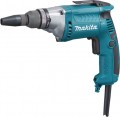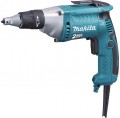Suitable for
Specific purpose of the tool.
This parameter is specified if the device has a specialization that significantly distinguishes it from the same type of general-purpose tools. It can be either a core specialization that defines all application options (an example is diamond drilling), or an additional functionality that expands general capabilities (an example is threading). Here is a more detailed description of today's most relevant appointments:
— For diamond drilling.
Diamond drilling(mainly with crowns) is used for materials of high hardness, which are not able to cope with conventional nozzles. Accordingly, the main features of a tool that allows such use are high power and the ability to carry significant loads. In addition, many (though not all) drills with this specialization are equipped with a stand (see below), a threaded spindle rather than a chuck is usually used to mount bits (see "Chuck Type"), and additional features often include water cooling. .
—
For drywall. Specialization, found mainly in screwdrivers (see "Device"). One of the mandatory features for a tool with this purpose is a depth gauge — it reduces the risk of damaging a rather delicate material, which is drywall. In addition, when working with drywall, it is often necessary to tighten the fasteners “quickly and in large quantities”, and to speed up the work, the screwdriver can be equipped with a special
...magazine nozzle; for more details, see "Complete set".
— For cutting threads. A feature found in some relatively low-powered tools, predominantly in the drill/driver format. For this, a special mode of operation is provided: first, the cartridge with the appropriate nozzle (die or tap) rotates clockwise, cutting the thread, and then in the opposite direction to remove / extract the nozzle. In addition, on the return stroke, the teeth of the nozzle pass over fresh cuts, clearing them of chips.
— For precision work. A tool originally designed for jobs that require precision and precision. Most of these models are screwdrivers (see "Device"), which have a very thin and light body that is comfortable to hold in your hand and allows you to make the most accurate movements. Note that the downside of this convenience is very low power; in fact, for more than "fine" work, such a tool is usually not designed.
— Automotive. A tool designed for use in a car — both for repairing the car itself (for example, changing a wheel), and for other work in the "field conditions", where the most convenient (or even the only available) power source is the car's on-board network. Accordingly, all car models have the ability to connect to such a network — usually through a standard cigarette lighter socket, although terminals for working directly from the battery can be supplied in the kit. And some automotive tools come with their own batteries; see "Food" for details.
— For spot welding. A specific type of drill designed for drilling connection points between spot welded parts. Such drills are especially popular in a car service — it is there that it often becomes necessary to remove a separate part welded “by points”, and the easiest way to do this is by drilling individual points. The specificity of such work lies in the fact that the junction cannot be drilled through — the working nozzle (drill or crown) must pass only through the upper layer of metal, almost without affecting the lower one. This means that the depth of drilling must be controlled very precisely. To do this, special limiters are used in spot welding drills, which look like clamps and allow you to set the drilling depth with an accuracy of fractions of a millimetre.Torque
Torque is the maximum force with which this model is capable of turning the working nozzle.
Higher torque gives more options, it allows you to cope with complex tasks such as drilling in hard materials, unscrewing stuck screws and nuts, etc. On the other hand, a lot of force requires corresponding power — and this, in turn, affects the dimensions , weight and cost of the tool itself, and also puts forward increased power requirements (mains power, battery capacity or pressure / compressor performance). And for some tasks, excessive torque is basically unacceptable, so for maximum versatility, it is desirable to have
torque control — and this affects the cost even more. And the more steps, the more optimally you can configure the tool to perform a particular type of work. So the general rule is this: when choosing, it is worth considering the specifics of the planned work, and not chasing the greatest working effort.
Detailed recommendations on choosing the optimal torque for different types of tools (see "Device") can be found in special sources. Here we note that it is of key importance primarily for screwdrivers, although it is also given for other types of tools. At the same time, in the “weakest” models, the maximum working force does not exceed 15 Nm, in the most powerful ones it is more than 150 Nm.
Weight
The total weight of the tool is usually the device itself, without attachments. For battery models (see "Power Source"), usually, the weight is indicated with a standard battery installed; for battery-powered models, the weight can be given both with and without batteries, but in this case this point is not particularly important.
Other things being equal, less weight simplifies work, increases accuracy of movement and allows you to use the tool for longer without tiring. However, note that high power and productivity inevitably increase the mass of the tool; and various tricks to reduce weight increase the price and can reduce reliability. In addition, in some cases, a massive design is more preferable. First of all, this applies to work with a large load — for example, drilling holes of large diameter, or making recesses with impact: a heavy tool is more stable, it is less prone to jerks and shifts due to uneven material, vibration of mechanisms, etc.
It is also worth noting that specific weight values are directly related to the type of tool (see "Device"). Screwdrivers are the lightest — in most of them this figure
does not exceed 500 g. Screwdrivers and drill drivers are more "heavy": their average weight is
1.1 – 1.5 kg, although there are many lighter (
0.6 – 1 kg) and heavier (
1.6 – 2 kg or more ) models. And clas
...sic drills and wrenches have the greatest weight: such a tool must be quite powerful, so for them 1.6 – 2 kg is an average, 2.1 – 2.5 kg is above average, and many units weigh more than 2, 5 kg.
